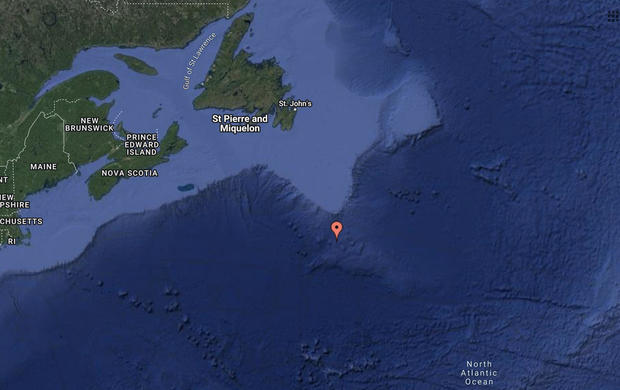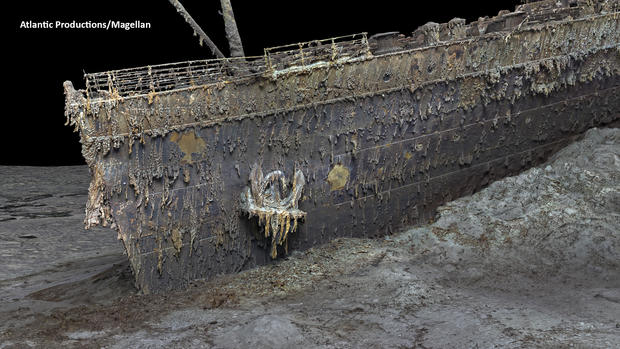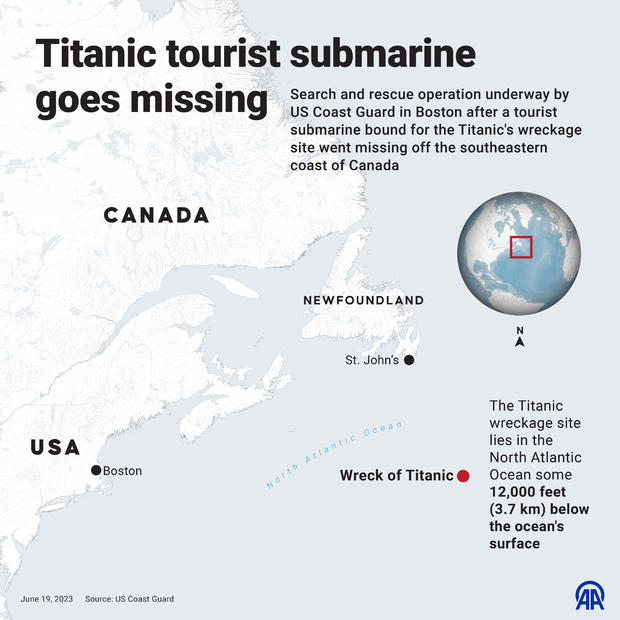See maps of where the Titanic sank and how deep the wreckage is amid search for missing sub
A submersible headed for the wreckage of the Titanic went missing in the Atlantic this week, prompting the Coast Guard to launch a search and rescue mission. The Titanic, which sank in 1912, has been explored dozens of times. Where is the wreckage located and how deep underwater is it?
What was the Titanic's planned path?
The RMS Titanic was dubbed "unsinkable" before it embarked on its maiden voyage in April 1912. It took off from Southampton, England, for New York City.
It first made stops in Cherbourg, France, and Queenstown, Ireland, before heading across the Atlantic. It was supposed to return via Plymouth, England, and Cherbourg — but never made it to New York. On April 15, 1912, with about 2,240 people on board, it hit an iceberg in the Atlantic Ocean. The massive ship broke into two parts and sank to the bottom of the ocean, killing about 1,500 people.
This area off the coast of Newfoundland, Canada has been dubbed "Iceberg Alley." Icebergs are large chunks of ice that break off of glaciers and float in the ocean. The icebergs in Iceberg Alley – located between Labrador and Newfoundland – come from the glaciers of Greenland, usually floating through in spring and summer.
Carpathia, another passenger liner that had departed from New York in April, was tasked with sailing toward the Titanic after it hit the iceberg. The ship helped rescue 705 people in lifeboats, then sailed back to New York City, arriving on April 18.
Where is the Titanic wreckage?
The ship was near Newfoundland, Canada, when it sank. It was just about 400 miles off the coast.
Most of the Titanic wreckage remains about 350 miles off the coast of Newfoundland, according to NOAA. The wreckage was first located in 1985 by marine explorer Robert Ballard, who returned about 20 years later to study the deterioration of the boat.
How deep is the Titanic wreckage?
The Titanic is sitting on the ocean floor, about 12,500 feet below sea level. The two broken parts of the ship – the bow and the stern — are more than 2,600 feet apart and are surrounded by debris.
Several expeditions have captured images of the ship before. In May, the first full-sized digital scan of the wreckage was released, showing the entirety of the wrecked ship in 3D.
What happened to the sub?
The submersible heading to the wreckage was run by OceanGate Expeditions, which organizes deep-sea expeditions that cost about $250,000 per person.
Five people were on board the sub when it went missing and the U.S. Coast Guard said it was searching for it about 900 miles off of Cape Cod, which is parallel to where the Titanic wreckage is.
The submersible crew started their dive on Sunday, after being ferried out by the Polar Prince, which lost contact with the underwater craft about 1 hour and 45 minutes after it began its dive, according to the Coast Guard.
British businessman Hamish Harding said in a Facebook post ahead of the expedition that he would be on the OceanGate trip, which he said took off from St. Johns, Newfoundland.
"The team on the sub has a couple of legendary explorers, some of which have done over 30 dives to the RMS Titanic since the 1980s," Harding wrote the day before they departed. "Due to the worst winter in Newfoundland in 40 years, this mission is likely to be the first and only manned mission to the Titanic in 2023. A weather window has just opened up and we are going to attempt a dive tomorrow."




